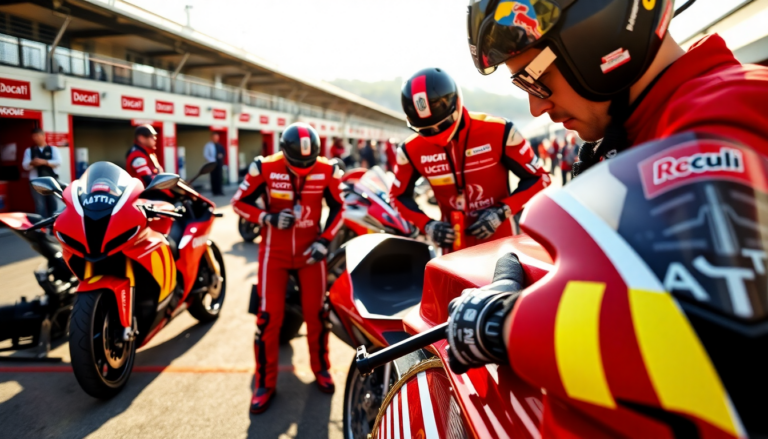Argomenti trattati
In the fast-paced world of MotoGP, Ducati has made a bold move by shifting its factory riders back to primarily 2024 specification bikes. This decision prompts some intriguing questions: What does this mean for their current performance, and how are rival teams adapting their strategies to close the competitive gap? With a rich history in motorcycle racing, Ducati’s choices are pivotal not only for their own team but also for the overall dynamics of the championship.
The Shift Back to 2024 Specifications
During preseason testing, Ducati’s factory riders, including Marc Marquez, Pecco Bagnaia, and Fabio Di Giannantonio, were introduced to brand-new machinery designed for the 2025 season. However, it didn’t take long for them to revert to the 2024 engine specifications, chassis, and aerodynamic setups. This strategic pivot means their current bikes closely resemble those raced by Gresini Racing’s Alex Marquez and Fermin Aldeguer, as well as Di Giannantonio’s VR46 teammate, Franky Morbidelli.
Despite Marc Marquez’s exceptional talent that has often seen him clinch podium finishes, both Bagnaia and Di Giannantonio have encountered significant challenges on the track. Bagnaia, in particular, has expressed frustration over a lack of feedback from his motorcycle’s front end upon corner entry, which hampers his ability to gauge the bike’s limits. This ongoing struggle has led him to experiment with various setup adjustments and even rethink his riding technique.
“I feel frustrated that my greatest strength—braking and entry—isn’t functioning well with this bike,” Bagnaia lamented, reflecting on his title as the reigning World Champion for 2022-2023. “Marc can adapt to any bike, but I need a solid connection with the front.” Recent races have highlighted a growing consensus: the GP24 model is outperforming the GP25 and its variants, a sentiment echoed by both Alex Marquez and rookie teammate Aldeguer, who have praised the GP24’s performance.
Understanding the Competitor Landscape
As Ducati navigates these hurdles, it’s fascinating to watch how competitors are responding to narrow the performance gap. Teams are constantly evolving their strategies, whether it’s through technological advancements or honing their riders’ skills to maximize their machines’ potential. For example, rivals might be ramping up investments in research and development to boost their bike’s aerodynamics or experimenting with innovative tire compounds for enhanced grip and stability.
Ducati’s choice to stick with older specifications could also embolden competitor teams, who may see this as a chance to exploit any perceived weaknesses in Ducati’s setup. In MotoGP, where every fraction of a second counts, each team’s strategic decisions can significantly impact their standings in the championship.
Additionally, the psychological aspect of racing plays a crucial role. The confidence a rider gains from a well-performing bike can greatly affect their performance on the track. As competitors begin to find their rhythm, Ducati must ensure that its riders have the tools necessary to regain their competitive edge.
Looking Ahead: Ducati’s Future in MotoGP
As we gaze into the future, one pressing question looms: will Ducati revert to the 2024 Desmosedici that propelled Bagnaia to success last season? The strategic choices Ducati makes in the coming months will be critical as they work to maintain their leading position in MotoGP. Their performance trajectory will largely depend on their ability to adapt and innovate within the current competitive landscape.
In conclusion, Ducati’s recent decisions highlight the delicate balance of performance, technology, and rider confidence in the fiercely competitive realm of MotoGP. As the season progresses, the interplay between Ducati’s choices and the reactions from rival teams will shape the championship landscape, making every race a thrilling spectacle for fans and competitors alike.

